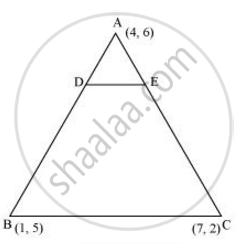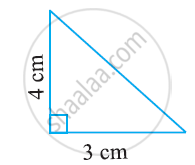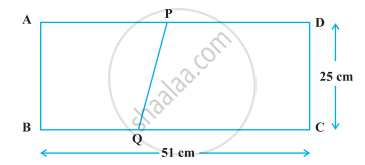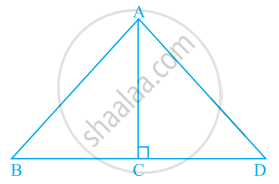Advertisements
Advertisements
Question
The vertices of a ΔABC are A (4, 6), B (1, 5) and C (7, 2). A line is drawn to intersect sides AB and AC at D and E respectively, such that
Solution

Given that (AD)/(AB) = (AE)/(AC) = 1/4
(AD)/(AD+DB) = (AE)/(AE+EC) = 1/4
(AD)/(DB)=(AE)/(EC) = 1/3
Therefore, D and E are two points on side AB and AC respectively such that they divide side AB and AC in a ratio of 1:3
Coordinates of Point D =
Coordinates of Point E =
Area of triangle =
Area of ΔADE =
Area of ΔABC =
Clearly, the ratio between the areas of ΔADE and ΔABC is 1:16.
Alternatively,
We know that if a line segment in a triangle divides its two sides in the same ratio, then the line segment is parallel to the third side of the triangle. These two triangles so formed (here ΔADE and ΔABC) will be similar to each other.
Hence, the ratio between the areas of these two triangles will be the square of the ratio between the sides of these two triangles.
Therefore, ratio between the areas of ΔADE and ΔABC =
APPEARS IN
RELATED QUESTIONS
Find the area of a triangle with vertices at the point given in the following:
(1, 0), (6, 0), (4, 3)
Find the area of the following triangle:

The area of a triangle is 5. Two of its vertices are (2, 1) and (3, −2). The third vertex lies on y = x + 3. Find the third vertex.
Four points A (6, 3), B (−3, 5), C(4, −2) and D (x, 3x) are given in such a way that
If the coordinates of the mid-points of the sides of a triangle are (1, 1), (2, —3) and (3, 4), find the vertices of the triangle.
Find the third vertex of a ΔABC if two of its vertices are B(-3,1) and C (0,-2) and its centroid is at the origin
If the area of triangle ABC formed by A(x, y), B(1, 2) and C(2, 1) is 6 square units, then prove that x + y = 15 ?
The dimensions of a rectangle ABCD are 51 cm × 25 cm. A trapezium PQCD with its parallel sides QC and PD in the ratio 9 : 8, is cut off from the rectangle as shown in the following figure. If the area of the trapezium PQCD is

The area of a triangle with vertices A, B, C is given by ______.
In the given figure, ratio of the area of triangle ABC to the area of triangle ACD is the same as the ratio of base BC of triangle ABC to the base CD of ΔACD.

